Examining the W&OD Trail as a Beloved Northern Virginia Asset and National Model
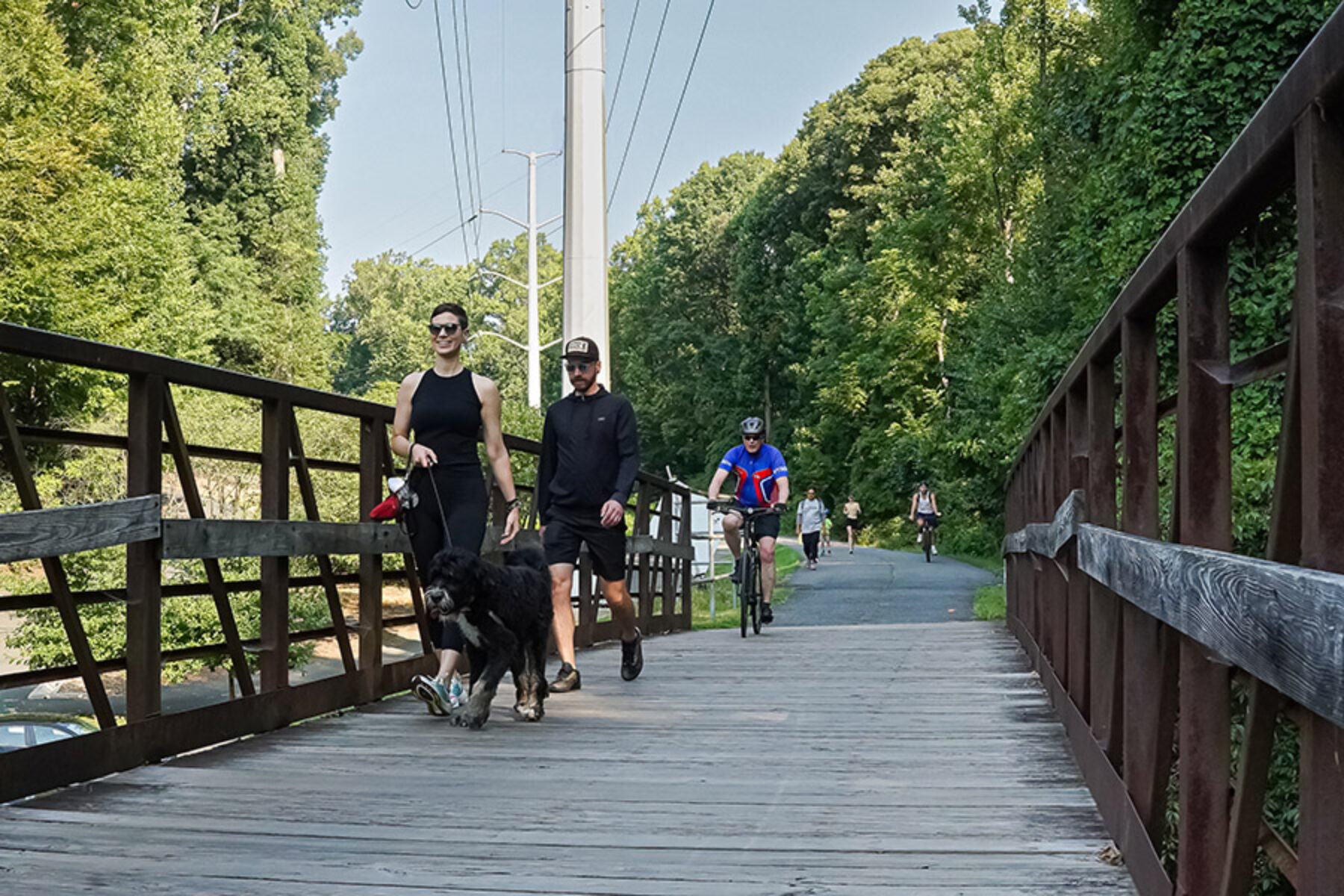
In 2012, Beth and Dave Meyer were considering opening up a bike shop in the Washington, D.C., suburb of Herndon, Virginia, in an old downtown feed store that had mostly sat vacant for a decade. It was a sleepy block back then, Beth Meyer said, but there was a lot of life passing by just across Lynn Street from this storefront, on the Washington and Old Dominion Railroad Regional Park.
The W&OD, as it’s commonly called, is one of the country’s oldest major rail-trails, which celebrated its 50th anniversary in 2024. It runs 45 miles along a former railway and current Dominion Energy power line corridor, from the Shirlington neighborhood in Arlington out west to Purcellville. The trail draws 2 million to 3 million users annually to its paved straightaway and accompanying 32 miles of gravel path, according to NOVA Parks, which manages it.
“I remember coming out here on a kind of windy, blustery, October evening, getting a Dairy Queen and sitting on the bench over there,” Meyer said, nodding to a seat across Lynn Street that overlooks the trail and a quaint downtown green space that houses the Herndon Depot Museum. “Just counting people going by—walkers, runners, cyclists, everything.”
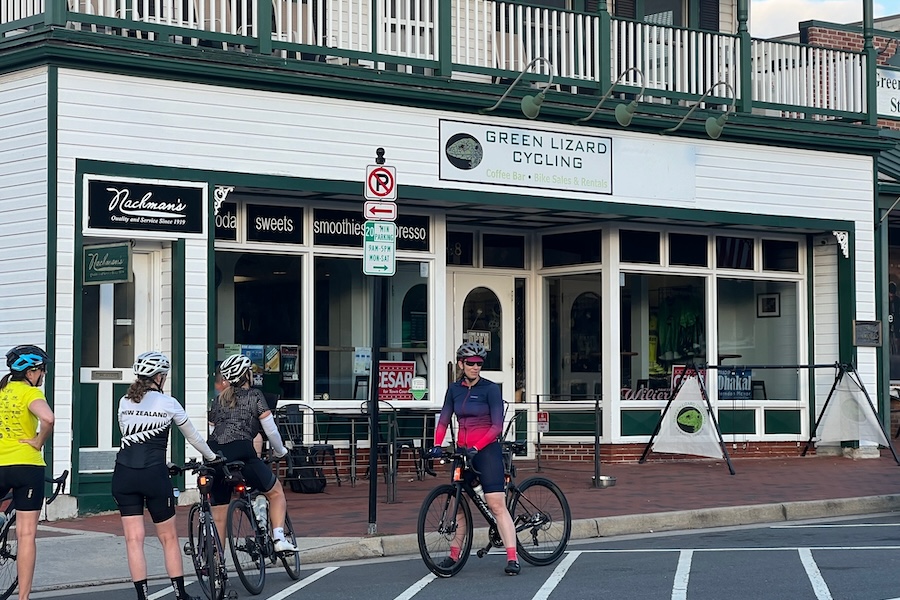
Twelve years later, in the throes of an early July heat wave, nearly every tabletop was occupied at 2 p.m. in the afternoon at Green Lizard Cycling—the store the Meyers opened. Some customers waited their turn for the shop’s mechanics to finish work on their world-class road bikes. Others were simply meeting neighbors for coffee or were weekend warriors popping in for a mid-ride beer and water bottle refill.
“We’re like a community—a really long, skinny community,” said Meyer of the lengthy W&OD.
“For as many people who … are coming in from out of town to visit this trail, there are 25 people locally who are using this trail.”
— Kevin O’Brien, Virginia Organizer, Washington Area Bicyclist Association
W&OD Trail
Stretching for 45 miles in Northern Virginia—the W&OD Trail has been a mainstay for millions of people over five decades. With businesses, schools, parks and cultural attractions booming along the entire corridor alongside neighborhoods and transit, the rail-trail—one of the earliest to influence Congress—is today a regional + national icon.
LENGTH: 45 miles (adjacent 32-mile gravel horse path)
ENDPOINTS: Shirlington/Arlington and Purcellville
COUNTIES: Arlington, Fairfax, Loudoun
USES: Walking, bicycling, wheelchair accessible, inline skating, horseback riding, cross-country skiing
Find detailed information on the W&OD on the NOVA Parks website or TrailLink.com.
Bike Gravity
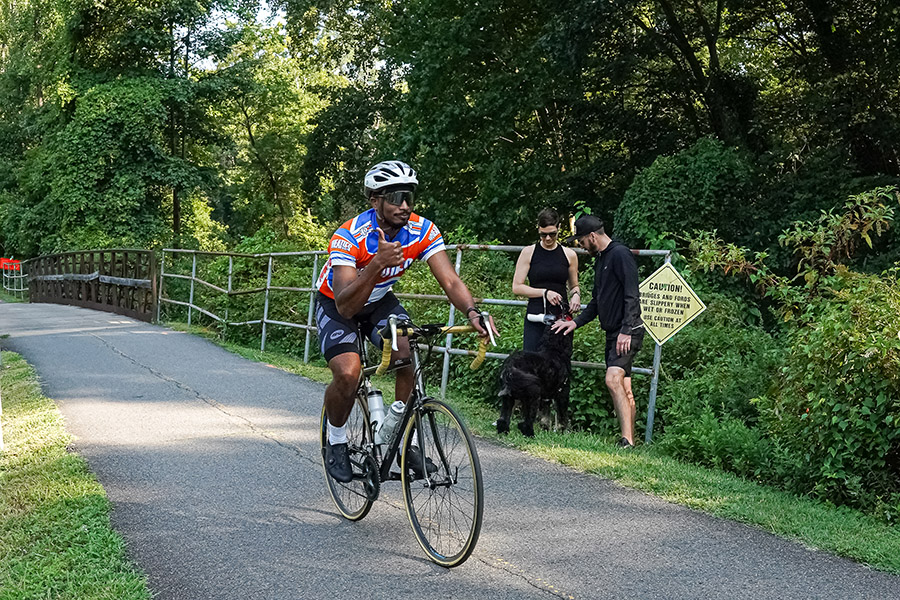
The last dedicated economic study of the entire W&OD corridor was commissioned by the Virginia Department of Conservation and published in 2004. Back then, people on the trail were spending about $12 million per year, with $7 million of that flowing directly into the Northern Virginia economy, thanks to a then-estimated 1.7 million adult visits annually.
Nowadays, there are seemingly 1.7 million breweries alone located either right next to the W&OD or within a mile or two of it. Farmers markets, bike and running-gear shops, and restaurants are among the establishments that lend itself to what Kevin O’Brien, Virginia organizer for the Washington Area Bicyclist Association (WABA), described as “small tourism” during a walk from Arlington to Falls Church along the Custis Trail and the connecting W&OD.
“It’s local,” he said. “It’s: ‘Hey, you got a free Saturday? Let’s go for a ride.’ For as many people who, like you, are coming in from out of town to visit this trail, there are 25 people locally who are using this trail.”
About 95% of the W&OD’s users were local, according to that 2004 study, and the trail is part of a growing number of businesses’ identities. Ten years ago, the Caboose Tavern, named after the trademark W&OD red caboose located just to the east, opened in an industrial block of Vienna, right off the W&OD. “Guests can walk, run, bike, skate—or even arrive by horse—to enjoy a fresh beer,” according to its website.
“Our relationship to the W&OD Trail is an integral part of what makes Caboose, Caboose,” said Shardei Sudler, the assistant general manager. “From our weekly run club and hosting charity rides to just your everyday biker stopping in for a quick drink, the W&OD Trail is where the community and Caboose meet.”
In Herndon, the Meyers knew the W&OD would be key to their success if they could encourage some of those 80 trail users an hour Beth counted back in 2012 to stop in. They built a coffee bar in the shop and started selling beer soon after they opened. They also rented out a parking space on the weekends and put a bike rack out front. Meyer said she’s found that cyclists in particular tend to stop when they see a full rack of bikes.
Over time, the shop built a community who comprise the Green Lizard Regulars. In a 2018 Herndon Connection article celebrating the Green Lizard’s fifth anniversary, regulars described it as “what makes Herndon, Herndon,” and a Fairfax County version of “Cheers.” Many regulars kick in funds or volunteer alongside the Meyers to help the Green Lizard lead bike drives for local kids and fundraisers for charities.
Such groups are building up and down the W&OD.
“The Bike Lane in Reston moved, from Reston Town Center to the trail,” Meyer said. “They moved and they put coffee in, and it’s great. We love to see it. [The W&OD] has become a place where people go to ride because they know they can stop at 10 different places and get a coffee or beer or muffin or banana smoothie—whatever they want. The more places built on the trail, the better we all are, unless we’re on top of each other.”
The length of the W&OD has kept that kind of pileup from happening. In August, Arlington’s Phoenix Bikes, a nonprofit youth education program and full-service bike shop, held an annual benefit fundraiser on the W&OD. About 50 riders raised over $77,000 for it. Businesses along all 45 miles of the trail, including Bikenetic in Falls Church, the Bike Lane in Reston, Plum Grove Cyclery in Leesburg and Sweet Rose Bakeshop in Purcellville donated time and resources to one of the latest causes to bring the long, skinny community together.
Dual Design
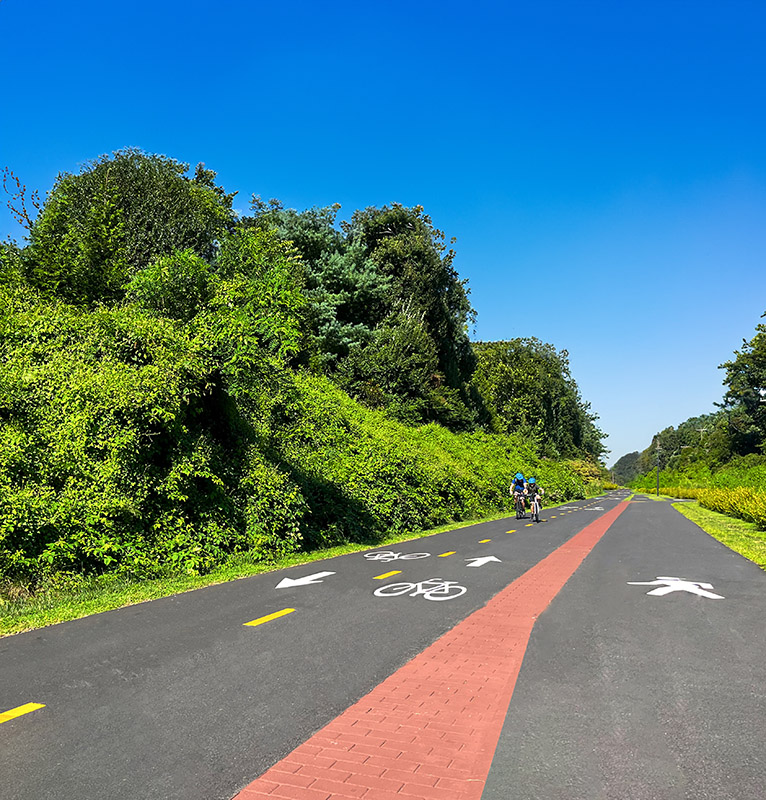
Fast forward 50 years from that first Falls Church ride, and there are a whole lot more people sharing the trail. There were more than a few times when I was on the trail that I got passed on my Capital Bikeshare bike by a faster cyclist in the middle of my effort to pass a pedestrian.
But not in Falls Church. There, a divided highway of sorts, and a sign that quickly explains it, greet you. Wheels go toward an 11-foot, two-lane bike path on the south side of the trail. Heels go toward an eight-foot path. It’s not the country’s first dual trail, but it’s the first on the W&OD.
Nearly $3.25 million from the Northern Virginia Transportation Authority and another $500,000 from the Virginia Department of Transportation funded the project; at the 2020 groundbreaking, then-Falls Church Mayor P. David Tarter said it was fitting that the city that launched the W&OD would “once again be at the forefront of better and healthier ways to move people.”
With ownership of a 100-foot-wide corridor along much of the W&OD, NOVA Parks has the space to explore expansion of this dual trail concept in the communities it partners with, and Gilbert said that’s a top priority. “This is the cutting edge of trail design and something we want to replicate in all the urban areas along the trail,” he said.
The dual trail’s design factored in environmental elements as well. Swales, modular wetlands and other low-impact development tools help improve stormwater runoff along the route.
Gilbert envisions the dual trail concept playing a vital role in establishing a new kind of mindset for trail users. The W&OD is routinely used as a way to get from one place to another. But if NOVA Parks is successful in establishing dual trails in more, or all, of the urban areas along the W&OD, Gilbert said the leisurely pace it would invite would be transformative.
“There will be more local foot use, pedestrian use,” he said. The concept also ties in with interest from some municipalities to install lights on portions of the trail. Herndon was the first, and the town of Leesburg, for one, is looking to begin a project in the winter. Gilbert said it all adds up to a more inviting experience that encourages trail users to stop and explore communities along parts of the W&OD that would serve as community promenades.
Opening Doors
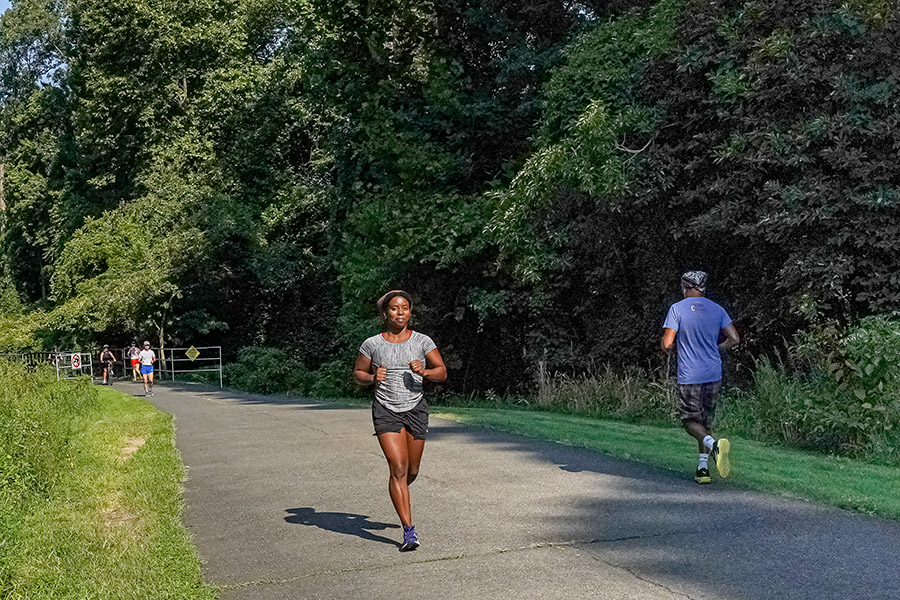
Fifty years ago, on Sept. 7, 1974, a publicity stunt of sorts served to showcase the first mile and a half of the W&OD Trail in Falls Church.
“There’s an old man and a little girl—probably like a grandfather and granddaughter—in German traditional outfits,” Paul Gilbert, NOVA Parks executive director, said of pictures he’s seen of the event. “He’s wearing lederhosen and a little felt hat. There’s [also] a late teen/early 20s guy with a cowboy hat. It’s very 1974.”
The Falls Church 1.5-mile path was an initial step agreed upon by the Virginia Electric and Power Company (VEPCO), NOVA Parks—then known as the Northern Virginia Regional Park Authority—and the city. By the mid-1970s, a comprehensive plan for the full trail’s future was well underway. But the corridor, which served freight and passenger rail traffic for over a century, belonged to VEPCO, which acquired it after a century-plus freight service ended in 1968.
While some of the country’s earliest rail-trail advocates were dismayed by this turn of events, it had a key side effect. The 45-mile corridor was almost entirely intact in 1977, when the park authority bought it from VEPCO for $3.6 million. Then in 1979, the first significant portion—from Falls Church to Vienna—opened, thanks in part to the first federal-funding demonstration grant program dedicated to rail-trail development. The W&OD was one of nine systems from a pool of 135 applicants across the country to receive a portion of the $5 million fund.
“Compared to most of the other trails, it was ahead of the curve,” said Peter Harnik, co-founder of Rails to Trails Conservancy, today the country’s largest advocacy organization for trails walking and bicycling. The W&OD’s development also had about a decade’s head start on RTC. Harnik said that as he and the late David Burwell, his fellow co-founder, began lobbying Congress and federal employees to invest in trail development, the W&OD was critical—because they and their staffers already used it.
“We’d say, ‘We’re here from Rails to Trails,’ and they would look at us really blankly, like, ‘What are you talking about?’” Harnik recalled. “And then we’d say, ‘You know, like the W&OD.’ And they’d say ‘Oh.’
“It opened up a lot of doors for us.”
Propelling a Vision for a Regional Trail Network
The W&OD Trail exemplifies the benefits of continued regional multiuse trail investment as part of the Capital Trails Coalition’s developing 881-mile network vision. The coalition aims to enhance equitable access across the D.C. area and close gaps in regions like Southeast Washington, D.C., Prince George’s County, Maryland, and Northern Virginia.
The Washington Area Bicyclist Association (WABA) is a coalition member, and Virginia Organizer Kevin O’Brien talked up the expansion effort while we walked the Custis and W&OD trails on a weekday morning as traffic dragged on neighboring Interstate 66. Building out the trail network, he said, will offer more commuters the opportunity to dodge that mess, save money, help the environment and pedal to work. It would also decongest traffic on the W&OD in the process.
A recent report commissioned by the coalition looked at the benefits of a completed network from numerous perspectives, including:
- $433 million in lifetime carbon storage value by reducing vehicle travel by 49 million miles annually
- $517 million saved in public health costs
- $941 million in local annual spending
- $9.9 billion in increased property value over 25 years
Above It All
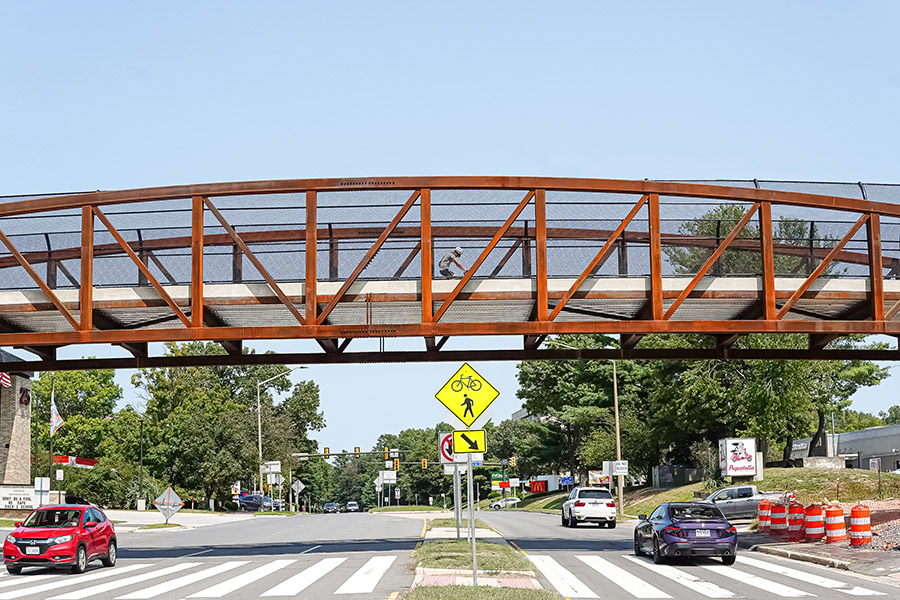
NOVA Parks continues its work with partner agencies to build a safer trail, which features 70 cross streets along its path. As the region surrounding the W&OD grows, NOVA Parks and its partners respond.
When I met Gilbert, we got iced coffees in a glistening corporate park in Reston, surrounded by even more futuristic buildings springing up around it. As Reston has developed, the intersection on Wiehle Avenue where rail-trail traffic meets car traffic has grown dicier, and it was always inelegant. The trail crossing is just north of the traffic lights at Wiehle and Sunset Hills Road. “So you’re coming around that corner and beginning to hit the gas when 20 bikes go across,” said Kevin Casalenuovo, W&OD park manager.
Not to mention that just north of the trail intersection, there’s a fire station. “[The various elements together] just cause confusion … no one knows what to do,” affirmed Mark Whaley, park operations superintendent for NOVA Parks.
But Gilbert and I were in Reston just weeks before a 50-ton, 147-foot-long and 16-foot-wide pedestrian bridge opened for trail users above Wiehle Avenue. The estimated $12 million project was led by the Fairfax County Department of Transportation in collaboration with NOVA Parks. And it’s not the only project of its kind on the trail in recent years. In 2021, a Virginia Department of Transportation-led project resulted in a new bridge over Route 29 in Arlington, and the design phase is already complete for an overpass above Sterling Boulevard in Loudoun County.
“We’re very fortunate to have partners, because a project like this would be a budget buster,” Gilbert said.
The latest effort has its fans. After the bridge was installed in April, the sign at the aforementioned Fairfax County Fire and Rescue Station changed to read: “We Wiehle like this new bridge.”
Heart of the Community
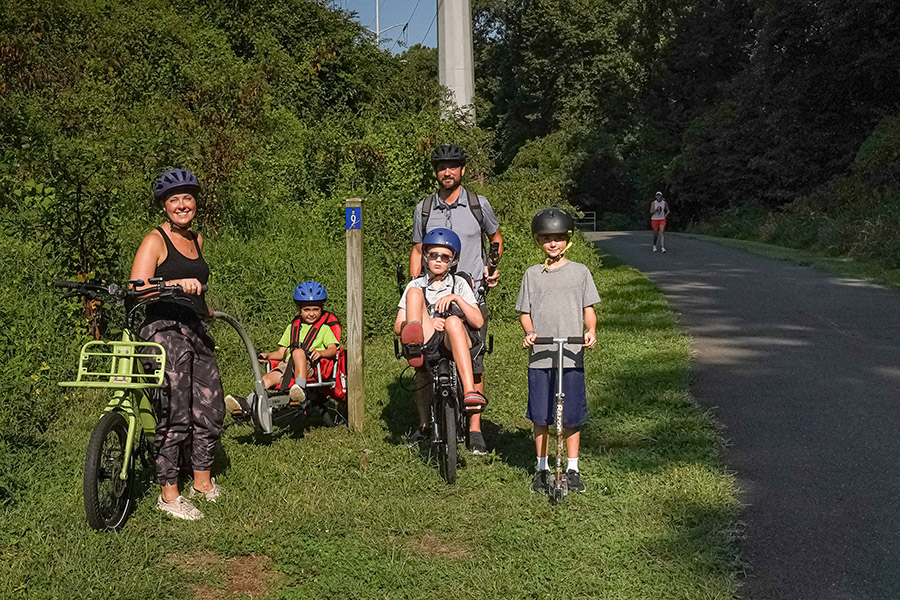
As noted, millions of people use the W&OD on a yearly basis. So it goes without saying that, although the trail has a speed limit, people who are bicycling too fast, or walkers or runners that might stray out of their side trajectory, can be a reality. Kelley Westenhoff, a Reston-based bike advocate and president of Friends of the W&OD Trail, has heard concerns from all viewpoints—noting the bike commuters, C&O Canal Towpath through riders, mountain bicyclists on their way to Lake Fairfax, runners, walkers, scooterers, equestrians and even one-wheelers that use the trail weekly.
To that end—and to ensure a general culture of safety and camaraderie on the trail—the friends group operates a Trail Patrol group. Trail users can quickly recognize their presence thanks to the neon-yellow vests they wear when putting hours and miles in on the path. “We don’t ask you to be a cop,” Westenhoff said. “We don’t ask you to be a medic. We don’t ask you to fix a bike. Just be out there.”
In 2023, patrollers logged 3,382 hours, said Trail Patrol President Laura Robinson. “I always say to trail patrollers, it’s hours that are important,” she said. “I don’t care about miles. Because it’s about presence on the trail.”
The presence builds community, and community is key, said Westenhoff, to making the trail experience better for all people. It’s at the heart of numerous efforts, including the first official 50th anniversary event. In fact, when the W&OD celebrated its birthday on Sept. 7, 2024, at the site of that first Falls Church test ride, the festivities began with an intentional effort to connect communities and build a shared ownership of the W&OD.
“How do we turn that passion and that love for the trail, that love for what they do, into the understanding of, ‘Hey, you’re not the only one out there?’” Whaley said. “As we’re looking into the future, how do we make the best experience for all the user groups? It’s one of the things we should celebrate—how far we’ve come and the knowledge that we need to keep going.”
Building Blocks
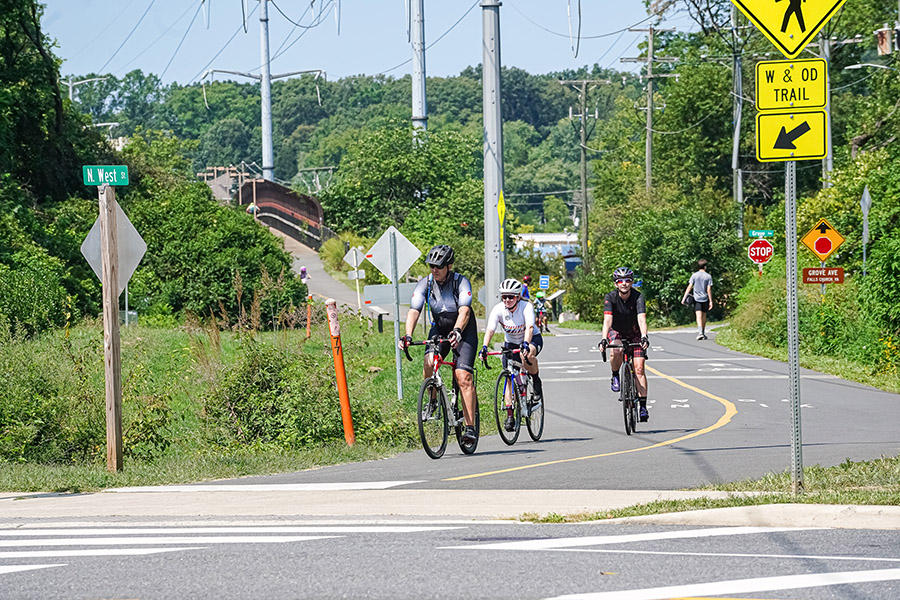
Jonathan Wiley, a fifth-generation Washington, D.C., resident who lives in the Georgetown neighborhood, was at the Green Lizard when I visited, waiting to get a different cassette for an upcoming trip through the Pyrenees—one of the toughest sections of the Tour de France. Wiley said he used the W&OD as a launching pad to become an avid cyclist, and it was the trail that first prepared him for such an endeavor.
A longtime runner, Wiley, 34, came to cycling in his late 20s after a friend at work talked up the sport, and the trail. Not having to worry about riding alongside cars allowed Wiley to build up his endurance and grow comfortable riding in the drop position. It was where he completed his first century ride.
Yes, he had to be mindful of other people and car traffic passing at intersections, but he said the W&OD served as a safe space to learn to take cycling seriously. Now he feels capable of riding just about anywhere. “I would say the W&OD was one of the most fundamental building blocks of my whole cycling journey,” Wiley said.
This article was originally published in the Fall 2024 issue of Rails to Trails magazine and has been reposted here in an edited format. Subscribe to read more articles about remarkable trails while also supporting our work.

Donate
Everyone deserves access to safe ways to walk, bike, and be active outdoors.
